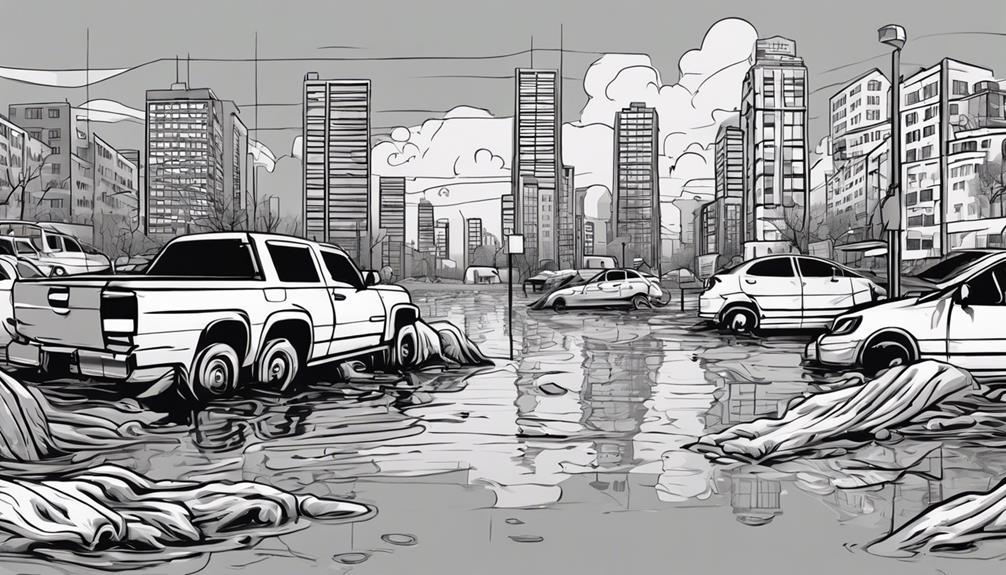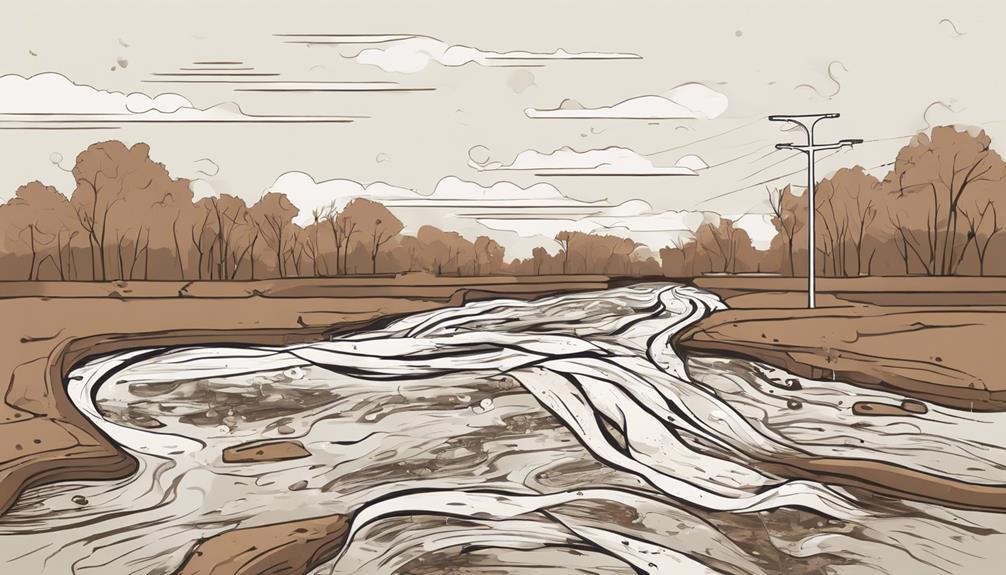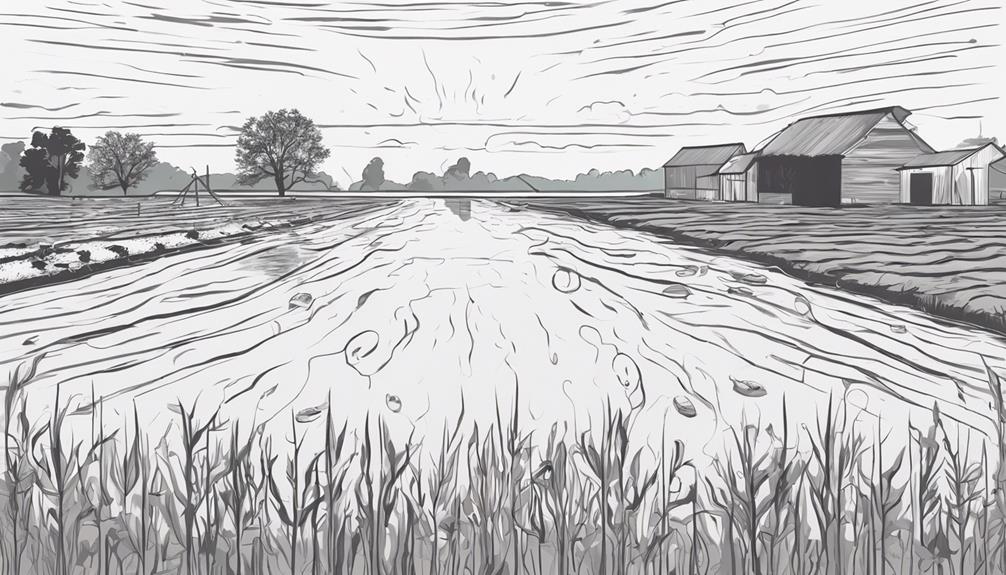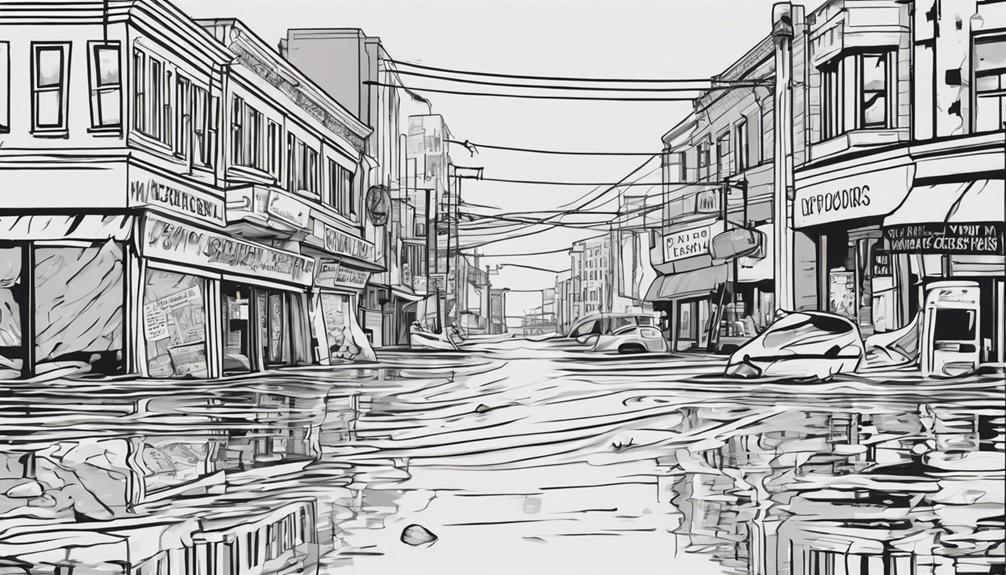Floods, natural phenomena with potent repercussions, wield a profound impact on both human settlements and the environment. These catastrophic events can trigger a cascade of consequences, encompassing everything from infrastructure destruction to the displacement of entire communities. However, the ramifications of floods extend far beyond the initial devastation they cause, permeating various aspects of society and ecology. By examining the intricate web of effects floods unleash, a deeper understanding emerges, shedding light on the complexities inherent in mitigating and recovering from such calamities.
Key Takeaways
- Floods result in habitat destruction, water contamination, and ecosystem disruption.
- Community displacement leads to overcrowding, challenges in accessing necessities, and long-term psychological effects.
- Contaminated water post-flood increases health risks like waterborne diseases and mosquito-borne illnesses.
- Infrastructure damage causes economic consequences, disrupts essential services, and requires extensive rebuilding efforts.
Environmental Impact of Floods

Flooding exerts a profound influence on the environment, causing habitat destruction, water source contamination, and ecosystem disruption. The environmental impact of floods is significant, with repercussions extending beyond the immediate inundation. Ecosystems are particularly vulnerable to the effects of flooding, as natural habitats are disrupted, leading to a loss of biodiversity and long-term consequences. Soil erosion, a common consequence of floods, further exacerbates the damage to ecosystems by destabilizing the delicate balance of the environment.
Moreover, aquatic species, such as salmon, face increased risks during flooding events, including habitat loss and water contamination. The disruption caused by floods can also trigger landslides, posing additional threats to ecosystems. The vulnerability of certain species, like fish and one-horned rhinos, is heightened by flooding, potentially leading to their displacement or increased susceptibility to environmental pressures. Understanding the intricate interplay between flooding and ecosystems is crucial for implementing effective conservation strategies in the face of these natural disasters.
Community Displacement
Community displacement resulting from inundations necessitates prompt and organized relocation efforts to mitigate adverse consequences on affected populations. Floods can force entire communities to evacuate, leading residents to seek temporary shelter in evacuation centers. However, this displacement can result in overcrowding in these centers, elevating the risk of disease outbreaks and tensions among the displaced individuals. Accessing basic necessities like food, water, and medical care becomes challenging for displaced communities, increasing their vulnerability. Moreover, the disruption caused by community displacement can have long-term psychological effects, especially on children and the elderly. Rebuilding these communities post-flooding is a complex and time-consuming process that requires coordination among various agencies and resources. Therefore, addressing community displacement in the aftermath of a flood is crucial to ensuring the well-being and safety of the affected populations.
Contamination of Water Sources

The pollution of water sources following inundations introduces significant health and environmental concerns. Floods can contaminate water sources with various pollutants like pesticides and industrial chemicals, posing risks to human health and aquatic ecosystems. One of the major risks associated with contaminated floodwater is the spread of waterborne diseases. These diseases, such as cholera and dysentery, can rapidly propagate through communities that rely on contaminated water sources post-flooding. The long-lasting impacts of polluted water sources can have devastating effects on public health, leading to widespread health issues and economic burdens. The table below highlights the key points related to the contamination of water sources following floods:
| Contamination of Water Sources | |||
|---|---|---|---|
| Introduction | Health Risks | Environmental Impact | Long-Term Consequences |
| Pollutants like pesticides and industrial chemicals can contaminate water sources | Risks to human health and aquatic ecosystems | Adverse effects on the environment | Devastating impacts on communities |
Destruction of Infrastructure
The destruction of infrastructure caused by floods can have severe consequences on a community's functionality and safety. Infrastructure damage leads to economic repercussions, requiring costly repairs and posing challenges in the recovery process. These impacts highlight the critical need for effective flood risk management strategies to mitigate the destruction of essential infrastructure.
Infrastructure Damage
What are the critical impacts of infrastructure destruction caused by flooding events? Floods can wreak havoc on infrastructure, leading to extensive damage to essential components such as roads, bridges, and buildings. This destruction results in severe disruptions to transportation and communication systems, hindering emergency response efforts and daily activities. Additionally, water distribution infrastructure is often compromised during floods, causing water shortages and sanitation issues. Power outages are another common consequence, as electrical infrastructure is susceptible to damage. The aftermath of infrastructure damage due to floods results in substantial economic costs associated with repairing and rebuilding the affected structures. These impacts underscore the importance of implementing effective flood management strategies to mitigate infrastructure damage and enhance resilience against future flooding events.
Economic Impact
Given the profound implications of infrastructure damage caused by flooding, the economic repercussions stemming from the destruction of essential structures warrant meticulous examination. The economic impact of infrastructure damage due to floods includes:
- High Costs: Repairing infrastructure post-floods can result in exorbitant expenses, burdening communities with substantial financial obligations.
- Long-Term Disruptions: Communities may face prolonged disruptions as they endeavor to restore essential infrastructure, leading to extended periods of inconvenience and economic strain.
- Business Closures: Damage to infrastructure can force businesses to cease operations, resulting in financial losses and potential long-term repercussions on the local economy.
These factors underscore the critical importance of safeguarding infrastructure against the destructive forces of flooding to mitigate the far-reaching economic consequences.
Agricultural Losses

Devastating flooding events pose a critical threat to agricultural sustainability through profound economic ramifications. Floods can result in significant agricultural losses, impacting both crops and livestock. The destruction of crops during floods not only burdens farmers financially but also disrupts food supply chains, potentially leading to increased food prices in affected regions. Additionally, the loss of livestock during floods further exacerbates the economic strain on the agricultural sector. Moreover, soil erosion and sedimentation caused by floodwaters can significantly affect crop yields and agricultural productivity in the long term. The contamination of fields with pollutants carried by floodwaters also poses a risk to the quality and safety of agricultural produce. Addressing agricultural losses due to floods is crucial for maintaining food security and sustaining the livelihoods of farmers. Efforts to mitigate these losses should be prioritized to ensure the resilience and sustainability of agricultural systems in flood-prone areas.
Health Risks and Diseases
Exposure to floodwaters can significantly heighten the susceptibility to various health risks and diseases, posing a severe threat to public health in affected regions. The aftermath of a natural disaster like a flood can lead to a range of health issues, including:
- Waterborne Diseases: Contamination of water sources during floods increases the risk of waterborne diseases such as cholera and typhoid, as individuals may consume or come into contact with polluted water, leading to severe gastrointestinal infections.
- Vector-Borne Diseases: Standing water left behind by floods creates ideal breeding grounds for mosquitoes, elevating the risk of vector-borne diseases like malaria and dengue fever, which are transmitted through mosquito bites and can cause significant morbidity and mortality.
- Zoonotic Diseases: The displacement of wildlife during floods can result in a higher risk of zoonotic diseases, where pathogens are transmitted from animals to humans. This increased interaction between humans and wildlife can lead to outbreaks of diseases that pose additional challenges to public health systems already strained by the natural disaster.
Erosion and Sedimentation

Floods can have significant consequences on the environment, particularly concerning erosion and sedimentation. The displacement of soil and sediment caused by flooding can lead to issues such as soil loss and instability of riverbanks. Understanding the effects of erosion and sedimentation is crucial in managing the impacts of floods on landscapes and water systems.
Soil Loss Impact
The impact of floods on soil loss through erosion and sedimentation is a critical concern for agricultural sustainability and ecosystem resilience.
Effects of Soil Loss from Floods:
- Fertile Topsoil Loss: Floods can lead to significant soil erosion, resulting in the loss of fertile topsoil crucial for plant growth.
- Nutrient Displacement: Erosion caused by floodwaters displaces soil nutrients and essential organic matter, impacting plant growth and agricultural productivity.
- Aquatic Ecosystem Impact: Sedimentation in water bodies due to flooding can disrupt aquatic ecosystems, reduce water quality, and harm aquatic species.
Soil loss through erosion and sedimentation during floods poses a substantial threat to both agricultural systems and the overall health of ecosystems, emphasizing the need for effective mitigation strategies.
Riverbank Stability Concerns
Erosion and sedimentation resulting from flooding events can significantly impact the stability of riverbanks, posing risks of instability and potential collapse. The impact of flooding can weaken the structure of riverbanks, making them more susceptible to erosion. Sedimentation, which occurs when floodwaters deposit soil, rocks, and debris, alters the composition of the riverbank and can lead to blockages that affect water flow and aquatic habitats. These changes not only disrupt ecosystems but also increase the likelihood of property damage and infrastructure loss. Therefore, monitoring and addressing erosion and sedimentation are crucial for maintaining riverbank stability, mitigating flood risks, and preserving the health of riverine environments.
Impact on Wildlife
Wildlife populations experience significant disturbances in their habitats and ecosystems due to the impact of flood waters. The effects of floods on wildlife can be profound and long-lasting, impacting various species in different ways:
- Displacement of Fish Species: Floods can displace fish species from their natural habitats, disrupting their migration patterns and affecting their ability to find food and reproduce.
- Water Contamination Risks: The contamination of water from floods poses significant risks to wildlife populations, especially aquatic organisms that rely on clean water for survival. Pollutants and debris carried by flood waters can have detrimental effects on these species.
- Harm to Ecosystems: Erosion and landslides resulting from flooding can cause physical damage to ecosystems where wildlife resides. This damage can alter the landscape, destroy habitats, and potentially lead to a decline in biodiversity.
Economic Consequences

Floods have far-reaching economic consequences that impact various sectors and communities, leading to significant financial burdens and disruptions. The costs of flooding are substantial, primarily stemming from property and infrastructure damage. In the agricultural sector, floods result in crop destruction and livestock loss, causing detrimental effects on farmers' livelihoods. Moreover, business closures are a common aftermath of floods, further exacerbating the economic toll by disrupting commerce and employment. Increased insurance premiums following floods add to the financial strain experienced by individuals and businesses alike. The cost of rebuilding after a flood is another significant economic consequence that communities face, requiring extensive resources and funding. Additionally, erosion and sedimentation caused by flooding can not only damage infrastructure but also alter landscapes, impacting ecosystems and habitats. These economic ramifications highlight the multifaceted challenges posed by floods and underscore the urgent need for effective mitigation and preparedness strategies to alleviate the financial burdens on affected areas.
Long-Term Recovery Challenges
The protracted process of rebuilding infrastructure, homes, and communities post-flooding presents enduring challenges that necessitate meticulous planning and sustained effort. The cost of flooding is a significant factor that influences the long-term recovery challenges faced by regions affected by floods. Here are three key aspects that contribute to the complexity of post-flooding recovery:
- Financial Burden: The economic repercussions of flooding can be staggering, with the cost of rebuilding infrastructure, homes, and businesses often exceeding initial estimates. This financial strain can impede the speed and effectiveness of long-term recovery efforts.
- Social Disruption: Communities impacted by floods may experience prolonged social disruptions, including displacement, loss of livelihoods, and strained social support systems. Addressing these social challenges requires targeted interventions and resources to rebuild community cohesion and support networks.
- Environmental Rehabilitation: Restoring the environmental damage caused by floods is a critical aspect of long-term recovery. Efforts to rehabilitate ecosystems and mitigate future environmental risks can be complex and resource-intensive, requiring sustained commitment to ensure long-lasting environmental health.
Frequently Asked Questions
How Do Floods Impact People's Lives?
Floods significantly impact people's lives by causing physical injuries, loss of life, and disrupting essential services and infrastructure. Emergency response to floods is crucial to mitigate these effects. The force of floodwaters can easily knock individuals off their feet, and even shallow water can sweep away vehicles. Contaminated floodwater poses health risks through exposure to sewage and pollutants. Financial losses are common, highlighting the comprehensive impact floods have on individuals.
What Are the Harmful Effects of Flood Essay?
Prevention methods play a crucial role in mitigating the harmful effects of floods. Implementing robust flood control measures, such as building levees, creating flood plains, and improving drainage systems, can significantly reduce the impact of flooding events. Adequate planning, early warning systems, and community preparedness are essential components in minimizing the devastating consequences of floods. By proactively addressing flood risks, we can safeguard lives, property, and the environment from the destructive aftermath of inundation.
What Are the 4 Causes of Flooding?
Flood prevention is crucial in mitigating the adverse impacts of flooding. Four primary causes of floods include heavy rainfall, snowmelt, storm surges, and flash floods. Understanding these factors allows for effective planning and implementation of strategies to reduce the risk of flooding. By addressing issues such as proper land use, urban planning, and sustainable water management practices, communities can work towards minimizing the damaging effects of flooding events.
What Are 10 Facts About Floods?
When discussing Flood Preparedness, it is essential to understand that floods are natural disasters with far-reaching effects. By comprehensively addressing flood risks, communities can mitigate the potential damages and protect lives and property. Implementing proactive measures, like early warning systems, evacuation plans, and infrastructure improvements, is crucial. Ensuring public awareness, emergency response readiness, and sustainable land use practices are key components in effective flood preparedness strategies.
Conclusion
In conclusion, floods act as a relentless force of nature, causing widespread devastation and upheaval in their wake. Like a turbulent river carving its path through a landscape, floods leave behind a trail of destruction that disrupts ecosystems, displaces communities, and challenges the resilience of society. The aftermath of a flood is akin to a turbulent storm that tests the mettle of humanity, urging us to confront the fragility of our existence in the face of nature's unyielding power.
